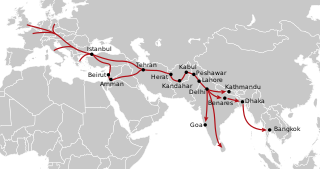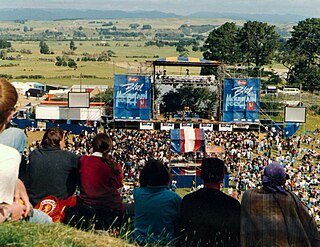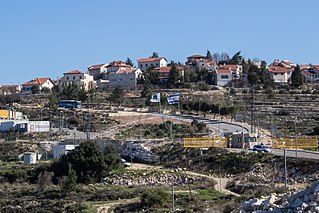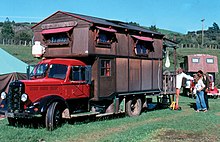
A bus is a road vehicle that carries significantly more passengers than an average car or van, but less than the average rail transport. It is most commonly used in public transport, but is also in use for charter purposes, or through private ownership. Although the average bus carries between 30 and 100 passengers, some buses have a capacity of up to 300 passengers. The most common type is the single-deck rigid bus, with double-decker and articulated buses carrying larger loads, and midibuses and minibuses carrying smaller loads. Coaches are used for longer-distance services. Many types of buses, such as city transit buses and inter-city coaches, charge a fare. Other types, such as elementary or secondary school buses or shuttle buses within a post-secondary education campus, are free. In many jurisdictions, bus drivers require a special large vehicle licence above and beyond a regular driving licence.

A hippie, also spelled hippy, especially in British English, is someone associated with the counterculture of the 1960s, originally a youth movement that began in the United States during or around 1964 and spread to different countries around the world. The word hippie came from hipster and was used to describe beatniks who moved into New York City's Greenwich Village, San Francisco's Haight-Ashbury district, and Chicago's Old Town community. The term hippie was used in print by San Francisco writer Michael Fallon, helping popularize use of the term in the media, although the tag was seen elsewhere earlier.

Hippie trail is the name given to an overland journey taken by members of the hippie subculture and others from the mid-1950s to the late 1970s travelling from Europe and West Asia through South Asia such as Afghanistan, Pakistan, India, Nepal, Sri Lanka, Bangladesh to Thailand. The hippie trail was a form of alternative tourism, and one of the key elements was travelling as cheaply as possible, mainly to extend the length of time away from home. The term "hippie" became current in the mid-to-late 1960s; "beatnik" was the previous term from the later 1950s.

A recreational vehicle, often abbreviated as RV, is a motor vehicle or trailer that includes living quarters designed for accommodation. Types of RVs include motorhomes, campervans, coaches, caravans, fifth-wheel trailers, popup campers, and truck campers.
An alternative lifestyle is a lifestyle perceived to be outside the norm for a given culture. The phrase "alternative lifestyle" is often used pejoratively. Description of a related set of activities as alternative is a defining aspect of certain subcultures.

The Battle of the Beanfield took place over several hours on 1 June 1985, when Wiltshire Police prevented The Peace Convoy, a convoy of several hundred New Age travellers, from setting up the 1985 Stonehenge Free Festival in Wiltshire, England. The police were enforcing a High Court injunction obtained by the authorities prohibiting the 1985 festival from taking place. Around 1,300 police officers took part in the operation against approximately 600 travellers.
Rock music in New Zealand, also known as Kiwi rock music and New Zealand rock music, rose to prominence first in 1955 with Johnny Cooper's cover version of Bill Haley's hit song "Rock Around the Clock". This was followed by Johnny Devlin, sometimes nicknamed New Zealand's Elvis Presley, and his cover of "Lawdy Miss Clawdy". The 1960s saw Max Merritt and the Meteors and Ray Columbus & the Invaders achieve success. In the 1970s and early 1980s the innovative Split Enz had success internationally as well as nationally, with member Neil Finn later continuing with Crowded House. Other influential bands in the 1970s were Th' Dudes, Dragon and Hello Sailor. The early 1980s saw the development of the indie rock "Dunedin sound", typified by Dunedin bands such as The Clean, Straitjacket Fits and The Chills, recorded by the Flying Nun record label of Christchurch. New Zealand's foremost hard rock band Shihad started their long career in 1988. Since 2018 this title is now undoubtedly held by New Zealand Māori metal band Alien Weaponry who have achieved huge success in Europe and the USA.

New Age Travellers are people located primarily in the United Kingdom generally espousing New Age beliefs with hippie or Bohemian culture of the 1960s. New Age Travellers used to travel between free music festivals and fairs prior to crackdown in the 1990s. New Traveller also refers to those who are not traditionally of an ethnic nomadic group but who have chosen to pursue a nomadic lifestyle.
Bedford Vehicles, usually shortened to just Bedford, was a brand of vehicle manufactured by Vauxhall Motors, then a subsidiary of multinational corporation General Motors. Established in April 1931, Bedford Vehicles was set up to build commercial vehicles. The company was a leading international lorry brand, with substantial export sales of light, medium, and heavy lorries throughout the world.

Music festivals have a long and chequered history in New Zealand. The first large outdoor rock music festivals were Redwood 70 in 1970 and the Great Ngaruawahia Music Festival in 1973. The largest was the 1979 Nambassa festival, one of several Nambassa festivals held around that time, in Golden Valley, just north of Waihi.

Nambassa was a series of hippie-conceived New Zealand festivals held from 1976 to 1981 on large farms around Waihi and Waikino in the Waikato. They were music, arts and alternatives festivals that focused on peace, love, and an environmentally friendly lifestyle. In addition to popular entertainment, they featured workshops and displays advocating alternative lifestyle and holistic health issues, alternative medicine, clean and sustainable energy, and unadulterated foods.

Waikino is a small settlement at the eastern end of a gorge in the North Island of New Zealand alongside the Ohinemuri River, between Waihi and the Karangahake Gorge. The Waikino district lies at the base of the ecologically sensitive Coromandel Peninsula with its subtropical rainforests, steep ravines and fast moving rivers and streams. The cascades of the Owharoa Falls lie just to the south west of the settlement.

Waikino Music Festival was a 1977 music and alternatives event held on Bicknell's farm in the Waitawheta Valley between Waikino and Waihi, New Zealand. Between band set ups; solo artists, poets and storytellers, comedians, yoga demonstrations and ravers would entertain, enabling the show to continue without breaks. These ideas were even further developed at the subsequent Nambassa festivals.

Neve Daniel is an Israeli settlement in the West Bank. Located in western Gush Etzion south of Jerusalem and just west of Bethlehem, it sits atop one of the highest points in the area – close to 1,000 meters above sea level, and has a view of much of the Mediterranean coastal plain, as well as the mountains of Jordan. In 2021, it had a population of 2,360. It is organised as a community settlement and falls under the jurisdiction of Gush Etzion Regional Council.
The Nambassa Winter Show with Mahana was all about a bunch of aspiring young hippie entertainers who moved into a youth camp in West Auckland, out of which this community of 60 people produced and directed two musical theatrical productions and toured the North Island of New Zealand in a convoy of Mobile homes, buses and vans, performing at major centres and theatres throughout September and October 1978. While initially four main shows were scheduled for this collective theatre company, repeat and spontaneous performances around the nation saw this number of live performances increased to over 10. This theatrical extravaganza was organised by the Nambassa Trust as part of its national promotion of the arts and towards promoting its 1979 three-day music, crafts and Alternative lifestyle festival, which was held in Waihi and attracted 70,000 people.
The hippie subculture began its development as a youth movement in the United States during the early 1960s and then developed around the world.

Construction trailers are mobile structures (trailers) used to accommodate temporary offices, dining facilities and storage of building materials during construction projects.

The Bedford RL was the British military's main medium lorry, built by Bedford from the mid-1950s until the late 1960s. The lorry was based on the civilian Bedford S type, first introduced in 1950. They superseded the Bedford QL, and were in turn superseded by the Bedford MK/MJ.

Van-dwelling or vanlife is an unconventional lifestyle of living in a car, van or other motor vehicle. A person who lives in such a manner, either on a full or part-time basis, is known as a van dweller, car dweller or vehicle dweller. People who live this way by choice are typically seeking a more self-sufficient lifestyle characterized by freedom and mobility. They may perceive it as being a less regulated form of housing, or one that offers a lower cost advantage over standard housing, especially in regions susceptible to housing shortages. Other van dwellers may be one step away from living on the street or in a shelter.























